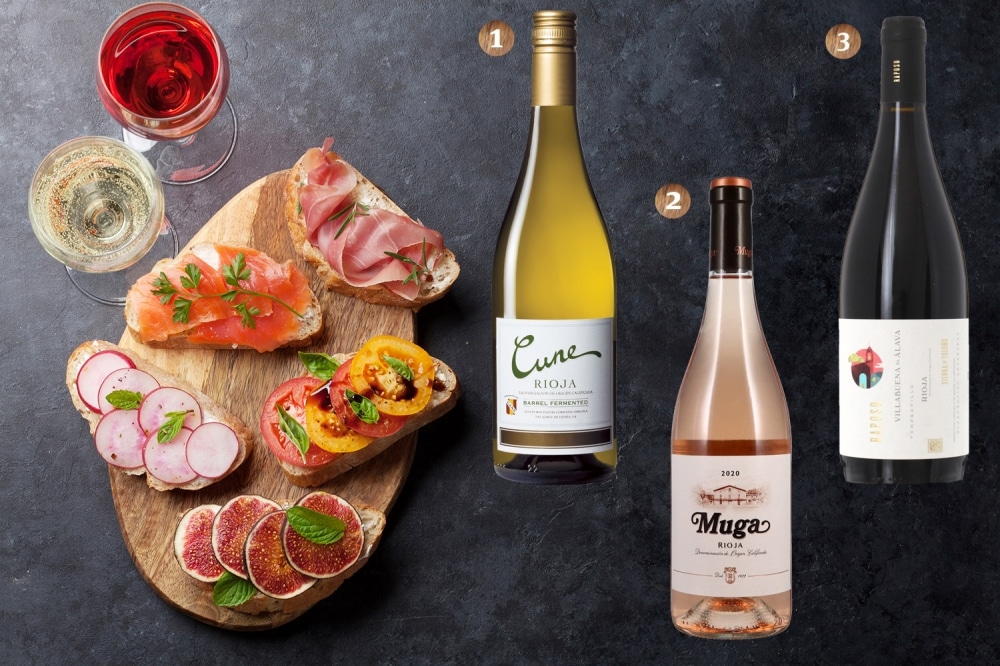Following a flurry of spellbinding press tastings in the capital, this week I’m shining the spotlight on three Riojan corkers.
Making probably the best-value fine wines in the world, Rioja is undeniably Spain’s most well-known wine region. It is spread across three autonomous communities and flanked to the north and south by mountains, lying about 350 km (210 miles) north of Madrid and 100 km (60 miles) south of Bilbao, with Spain’s second-longest river, the Ebro, running through the region from west to east.
Its unique setting is a crossroads of topographies, cultures and climates, and this variety is replicated in its wines. These range from region-wide blends to more artisanal productions that showcase a specific place, vineyard or variety.
Acting as the cornerstone of many of the region’s wines, the most planted grape variety is tempranillo, occupying nearly 80% of the vineyard surface.
While most traditional blends are based on this early-ripening variety and supplemented by cariñena (aka mazuelo), graciano, and/or garnacha (aka grenache, the dominant ingredient in Châteauneuf-du-Pape), it is becoming increasingly common to find single-varietal examples.
Although red wines dominate production, the historically important viura (aka macabeo)-based white wines have latterly seen renewed interest.
Now you know a little more, I recommend you try these…
1) Tip-top white Rioja
2019 Cune/Cvne Barrel Fermented Rioja Blanco (£8.99-£9.50, Majestic mix six & Co-op)
Don’t forget about white Rioja. Only around 10% of Rioja’s vines are light-skinned and viura is far and away the most planted white grape – around 70% of the total of this figure, with tempranillo blanco a distant second place.
One of Rioja’s great names, Compañia Vinícola del Norte de España (pronounced ‘coo-nee’), founded in 1879 in the iconic Barrio de la Estación railway station of Haro (the first town in Spain to have electric street lighting), is the producer behind this deftly-oaked white, which was fermented for around three weeks in new American oak casks.
Think beeswax, apple peel, citrus and pear with light oak-derived notes of nutmeg, vanilla, sandalwood and toast. Try it with main course vegetable dishes, roasted white meats, pork belly with Asian spices, risotto, seafood and creamy pasta dishes. A very good buy. 100% viura.
2) Must-try discounted pale rosado (pink wine) from the calcareous and ferrous clay soils of the upper Najerilla valley
2020 Muga Rioja Rosado (£8.25 offer, down from £9.50, The Wine Society)
A must-try discounted pale rosado (pink wine) from the calcareous and ferrous clay soils of the upper Najerilla valley. Cling on to summer with a bottle of this top-value, cut-price rosado.
Alluring wild strawberry, pink grapefruit, rose petal, peach and redcurrant aromas lead on to the tangy, succulent and gently creamy palate of this mouth-watering, fashionably pale pink garnacha tinta-viura blend, which was fermented for around four weeks in small wooden tanks of about 2,000 litres.
Would match nicely with rice dishes, salads, seafood, bouillabaisse, Brie/Camembert or aubergine parmigiana.
An exquisite weekday rosado that over-delivers for the price. Get in there quickly as it’s a steal now on offer at The Wine Society, the much-deserved, newly-crowned winner of ‘Outstanding Retailer of the Year’ at The Decanter Retailer Awards 2021.
3) Fresh, elegant, high-altitude, artisanal red from two old vineyards and a brilliant young winemaker
2018 Rioja Sierra de Toloño Tinto ‘Raposo,’ Rioja Alavesa (£19.50-£21.95, Lea & Sandeman)
A fresh, elegant, high-altitude, artisanal red from two old vineyards and a brilliant young winemaker. There is more to Rioja than oaky reds.
Sourced from two deep-rooted, 60 and 100-year-old organic vineyards situated around 500m above sea level in Villabuena de Álava, this pristine, unfined, unfiltered, small production (just 6,500 bottles) field blend of tempranillo and graciano was made by Sandra Bravo, one of the youngest members of the so-called Rioja ‘n’ Roll collective of nine brilliant winemakers from seven boutique wineries.
Made without ageing certification, this characterful red is spicy, floral, crunchy, refined and complex with bags of bright, refreshing, brambly, red berry fruits, framed by fine, sweet, caressing tannins and supported by a light chocolate note. Fermented and then aged in 3,000-litre oak foudres (not the standard 225l oak barrels).
Irresistibly good with cod with butter beans in a chorizo and tomato sauce, slow-cooked pork shoulder and pink lamb cutlets. This is fresh, elegant, modern Rioja at its outstanding best. It only gets better when left open for a day or two. Superb stuff from a soulful winemaker and winery on song.
RIOJA: THE FACTS
- Planted area: 65,811ha – 59,855 red grapes and 5,956 white grapes (by comparison, Great Britain has just 3,800ha under vine)
- Main grapes: Red Tempranillo, Garnacha, Graciano, Mazuelo (Cariñena), White Viura, Tempranillo Blanco, Verdejo and Sauvignon Blanc
- Main soil types: Clay-limestone, clay-ferrous and alluvial
- Rioja is the oldest Designation of Origin in Spain (1925) and the first to earn Calificada or DOCa status in 1991 (joined by Priorat in 2003)
- Rioja has circa 14,800 growers, 28 co-ops and 576 wineries with a bottling licence, and its DOCa holds the highest number of registered quality wineries (Spain has an estimated 4,000 in total)
- Nine out of 10 bottles are red, with around 10% a mix of both whites and rosados
- Rioja has the largest number of 225-litre oak barrels in the winemaking world – 1,371,679 on 31 December 2020
6 EXCEPTIONAL NEW-WAVE RIOJA BODEGAS (WINERIES)
For more information, visit the Rioja Wine Directory buyrioja.co.uk and follow the hashtag #RiojaWineMonth and @riojawine for updates on events and goings on during Rioja Wine Month on social media.
Follow James on Twitter @QuixoticWine








